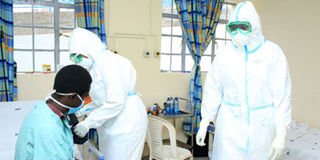Covid-19 patients could go home after day 10

Medics attend to a Covid-19 patient in an isolation ward at the Kenyatta National Hospital's Infectious Disease Unit in Mbagathi, Nairobi.
What you need to know:
- Research shows that by this time the virus might not be infectious.
- Training and sensitisation of CHVs will be done to ensure that patients at home do not pose a risk to the family and the public.
- Fifty-seven thousand will be trained in the next three to four days through an online module, Dr Amoth said.Healthcare workers will be trained in the next one to two weeks.
Covid-19 patients could soon start getting released to go and get home-based care after 10 days in institutionalised isolation.
Acting Health Director Patrick Amoth Sunday said the step is one of the guidelines issued by the World Health Organisation on early release of Covid-19 positive patients from the clinical care pathway.
“WHO reviewed data from other centres and now indicates that after the 10th day, even if you continue to spread the virus, those are likely to be break-down products of the virus that are not infectious,” Dr Amoth said.
He explained that the polymerise chain reaction (PCR) picks a particular part of the virus but cannot tell whether the virus is infectious or not, but research has shown that the virus mightnot be infectious after day 10 of isolation.
“In centres where testing is not practical, it means that a patient can be released after 10 days in isolation if the patient does not exhibit any symptoms like coughing, fever or difficulty in breathing. They could be released to go and get home-based care and isolation.
According to the WHO guidelines which the Ministry of Health is adapting for the local situation, for a patient to qualify for home-based care, he/she needs to have a Covid-19 positive report from the laboratory.
“You must be asymptomatic or have mild forms of the disease based on the triaging by doctors and clinicians, and must have no underlying illnesses such as diabetes, high blood pressure, chronic chest problems, chronic kidney problems and others,” said Dr Amoth.
These patients must have adequate space, preferably a separate room from the rest of the household members where they will stay during the isolation or quarantine. “It must be very well ventilated to decrease the risk of spreading the disease within the household,” he added.
Dr Amoth said it was imperative for all of the patients released to adhere strictly to infection-control guidelines, which include washing hands, sanitising and wearing masks.
The care iver must also have a mask and access to personal protective equipment like gloves, as well as a thermometer for checking a patient’s temperature.
“We will propose that no visitorl be allowed into the p room where the person is isolated or quarantined, except the caregiver,” he said.
Also, they must have a proper waste disposal system, as well as separate plates and cutlery for use strictly by the patient.
“Not everybody will qualify for home-based care. If you do not meet some of these conditions, then it only means you will go for institutional-based isolation or quarantine,” Dr Amoth added.
He advised patients on other medications to continue taking them, but noted that this will not be possible without the help of healthcare workers and community health volunteers (CHVs).
As a resullt, training and sensitisation of CHVs will be done to ensure that patients at home do not pose a risk to the family and the public.
Fifty-seven thousand will be trained in the next three to four days through an online module, Dr Amoth said.Healthcare workers will be trained in the next one to two weeks
“Working together with community health volunteers and other healthcare workers within the vicinity, we will have a plan for a referral in case the patient’s condition changes,” he said.
He said masks should always be worn in public since they have been proved to help reduce chances of contracting the virus.
“Home-based care is not new. It has been used before, especially with the advent of the HIV pandemic, when we released healthcare guidelines that went a long way in relieving stress from public health facilities. It had very good outcomes,” said Dr Amoth.





